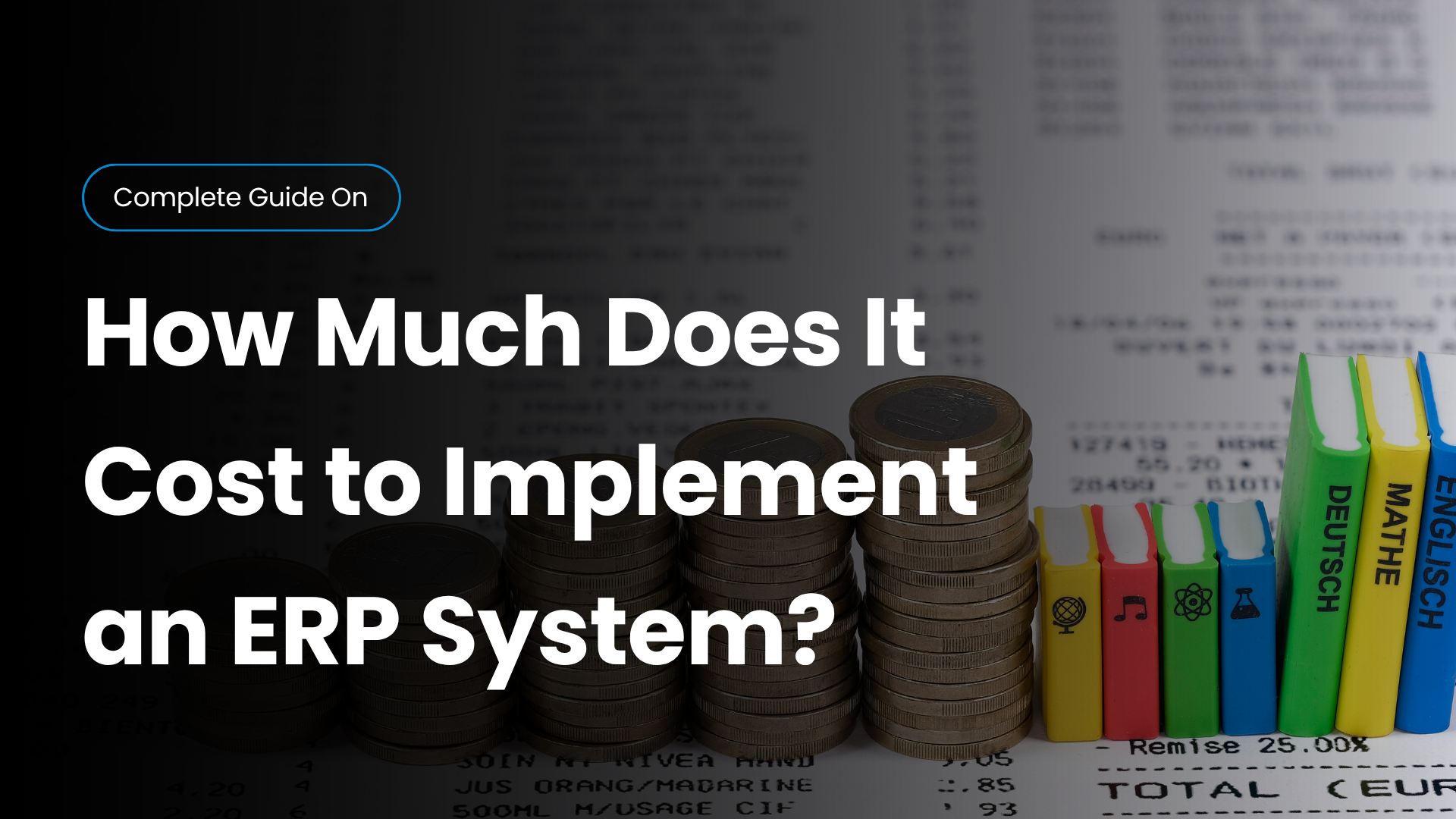If you’re a manufacturer and thinking about digital transformation, you’re likely asking, how much does it cost to implement an ERP system? That question has no one-size-fits-all answer. Every company has different needs, goals, and processes.
The total cost of ownership (TCO) includes more than just the software. It includes training and support, customization fees, IT infrastructure, and ongoing updates. Costs can range from tens of thousands to millions depending on what your business needs.
Table of Contents
What is a ERP System?
A ERP system connects everything—inventory, supply chain, production, HR, and finance. It’s like the brain of your factory. It automates tasks, tracks raw materials, manages orders, and keeps your teams in sync.
This kind of ERP system includes specialized modules like shop-floor scheduling, MRP (Material Requirements Planning), CAD module, and MES (Manufacturing Execution System). These tools help you run smoother operations and increase profits by reducing waste and improving visibility.
ERP Pricing: A Quick Overview
ERP software pricing depends on many things. A small shop may only spend $25,000. But a large company with several plants might pay over $1 million. Prices rise with more users, advanced tools, and ERP modules and integrations.
There are two main ERP pricing models. One is subscription-based licensing like in a cloud ERP. The other is perpetual licensing, used in on-premise ERP systems. Each has its own benefits and costs over time.
Factors That Affect ERP Cost

Software Licensing Fees
ERP licensing fees can make up a big part of your cost. In subscription-based licensing, you pay yearly or monthly. In perpetual licensing, you pay once but need to cover updates and support.
Your choice between cloud-based ERP vs on-premise ERP changes the licensing type. Cloud ERP usually means ongoing fees, while on-premise ERP has a big upfront cost.
Number of Users
The more people using the ERP system, the higher the price. Most vendors charge per user or offer user tiers. Departments like sales, production, and accounting all need access.
User licenses also vary by type—some need full access, others just need to view data. This will affect your overall ERP cost estimate.
Implementation Scope
Small projects might finish in weeks, while full enterprise rollouts can take years. Implementation costs rise as the scope expands.
A local manufacturer with one location has a simpler job than a multi-site operation. Every extra step—like linking to multi-currency support or CRM integration—adds cost.
Customization Requirements
Out-of-the-box tools rarely meet 100% of business needs. So many companies pay extra for ERP system customizations.
Adding special reports, workflows, or screens requires developers and testers. These customization fees grow fast when you want unique functions.
Integration with Existing Systems
Older systems often lack easy connections. If your ERP system needs to link with legacy apps, expect to pay for ERP modules and integrations.
Connecting CAD modules, supply chain platforms, or payroll software requires middleware or APIs. This adds both time and cost.
Ongoing Support & Maintenance
Once it’s live, your ERP system needs help to stay updated. ERP maintenance cost includes tech support, bug fixes, and security patches.
Some vendors include basic ERP vendor support, others charge per ticket or offer monthly plans. Don’t skip this—it keeps your business running.
Cloud vs. On-Premise Deployment
With cloud ERP, you rent space and power from a provider. Public cloud-based ERP is cheaper short term. Private cloud ERP offers more control and security.
On-premise ERP has high ERP infrastructure costs upfront but gives full control. Your choice depends on budget, data policy, and IT staff.
ERP Price Estimates by Business Size
Small Businesses
For ERP for small manufacturers, costs can range from $25,000 to $100,000. These businesses often choose cloud ERP for lower entry costs and faster setup.
They focus on core features like inventory, billing, and reporting. ERP subscription pricing is easier for them to manage.
Mid-Sized Manufacturers
A mid-sized plant might spend between $150,000 and $500,000. These companies need more ERP system complexity to manage production lines, vendors, and logistics.
They often use industry-specific ERP systems. These provide modules tailored for their sector without deep customization.
Large Enterprises
Big operations may invest $1 million or more. They need multi-currency support, multi-site tracking, and high-end analytics.
Many use hybrid models—combining on-premise ERP with cloud tools for flexibility. Their ERP project budget covers everything from hardware to global training.
Generic ERP vs. Industry-Specific ERP
Generic ERP systems work across many industries but often lack depth. You may need to buy add-ons or make changes to fit.
A manufacturing-specific ERP already includes modules like MRP, MES, and shop-floor scheduling. These systems lower your ERP implementation cost and save time.
How to Calculate ERP Implementation Cost
Use an ERP pricing calculator to break down all your costs. Include ERP infrastructure costs, licensing, training, support, and consulting.
For example, a company with 50 users might pay:
| Category | Estimated Cost |
|---|---|
| Licensing (Annual) | $60,000 |
| Training | $15,000 |
| Consulting | $25,000 |
| Data Migration | $10,000 |
| Customization | $20,000 |
| Total | $130,000 |
How to Create an Accurate ERP Budget
Conduct a Gap Analysis
Before you budget, check where you are and where you want to go. This is called a gap analysis. It helps you plan for process reengineering and avoid unforeseen ERP costs.
It also guides you on whether you need customization, new modules, or third-party tools.
Account for Hidden Costs
Even smart plans miss things. Don’t forget employee training costs, downtime, or new hardware. These hidden costs add up fast.
Keep a list of every expense in your ERP project budget so nothing slips through the cracks.
Include Change Management and Training
Getting your team on board is key. ERP training costs vary by location, method, and employee count.
Use videos, in-person workshops, or trainers. Factor in productivity dips while employees adjust.
Plan for Contingencies
Set aside a buffer—usually 10–20%. You might need extra help, tools, or changes mid-project.
Unexpected delays, tech issues, or team turnover are common. This extra budget saves stress later.
How to Gain Budget for ERP Adoption

Step 1: Build a Business Case
Make the case for value. Show how a new ERP system reduces costs, improves accuracy, and boosts delivery speed.
Use real numbers. Tie the system to goals like faster reporting or lower rework rates.
Step 2: Present Cost-Savings and ROI
Share expected gains from improved inventory management and streamlined processes. Show how the ERP system ROI pays for itself over time.
A recent study by Panorama Consulting shows 93% of companies improved operations post-ERP.
Step 3: Involve Key Stakeholders
Bring in teams from finance, IT, and operations. They will ask smart questions and help get approvals faster.
This also builds trust and shared ownership.
Step 4: Secure Executive Buy-In
Speak their language. Show how ERP supports strategy, growth, and customer experience.
Use terms like cost control, scalability, and innovation—not just software jargon.
Bespoke ERP vs. Off-the-Shelf ERP
Pros and Cons of Custom-Built ERP
A custom or bespoke ERP system fits your needs exactly. You decide every feature and flow.
But it costs more and takes longer. You’ll need skilled developers and strong project management.
Cost Implications
Customization fees rise with complexity. Testing, deployment, and support take extra time and money.
Off-the-shelf ERP saves time but may need workarounds or add-ons.
When to Choose Bespoke ERP
Use bespoke when your operations are truly unique. For example, a precision tool maker needing strict compliance rules.
If your processes don’t match any manufacturing-specific ERP, custom might be your best fit.
Is Building Your Own ERP a Cost-Effective Option?
Some companies try to build from scratch. This rarely saves money long-term. You’ll face high IT infrastructure costs, delays, and support problems.
Buying and customizing an existing ERP system gives better ROI and support options.
ERP Cost by Implementation Timeframes:
Fast rollouts (3–6 months) cost less but may miss features. Full rollouts (12–24 months) allow deep testing and training.
Shorter timelines work for cloud ERP. On-premise ERP often takes longer due to setup and integration needs.
Calculating ROI for Your ERP Project:
Operational Efficiency Gains
A good ERP system cuts waste and speeds up tasks. You’ll reduce double entries and missed deadlines.
This boosts efficiency, reduces error rates, and lowers rework.
Labor Cost Reductions
Automation replaces manual work. Fewer errors mean fewer hours fixing problems. Staff can focus on value-added tasks.
This leads to savings in payroll and overtime.
Inventory and Waste Control
Inventory management gets a big upgrade. You’ll order less, store less, and waste less.
A leaner supply chain boosts profits and lowers storage costs.
Better Forecasting & Reporting
With better data, you make better decisions. Sales, finance, and operations all get real-time insights.
Use this to adjust fast and stay competitive.
Making Informed ERP Investment Decisions
Choose the right ERP system based on size, industry, and goals. Consider future needs—don’t just solve today’s problems.
Compare ERP consulting services, vendor track records, and user reviews. Make sure your choice aligns with strategy, not just price.
FAQ:
What is the average cost of an ERP system for manufacturers?
Small firms may spend $25K–$100K. Mid-sized businesses might pay $150K–$500K. Large firms can spend over $1 million depending on scope.
Why do ERP costs vary so much?
Factors include company size, customization, deployment type, and number of users. Every ERP system is different.
Can I get an ERP system on a small budget?
Yes. Many cloud ERP options have low startup costs. You can scale later as you grow.
What are common hidden costs in ERP projects?
Common surprises include data migration, downtime, employee training costs, and change management.
How can I reduce ERP implementation costs without compromising quality?
Start with core features. Choose a trusted vendor. Invest in ERP consulting services to guide you and avoid mistakes.

